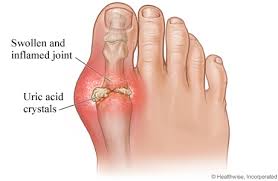What? Gout is a form of arthritis which is caused by the accumulation of uric acid crystals in joints. In this condition, due to a metabolic dysfunction, there is deposition of uric acid in and around the joints causing severe painfulness, swelling and restricted mobility of the affected joint. Men are more likely to get gout. Typical symptoms begin in ones late 30-40 s
• Certain conditions related to diet, eating a diet rich in meat and seafood (high-purine foods), and drinking too much alcohol and being overweight
Gout is associated with unusually high levels of uric acid, a waste product found naturally in the bloodstream. In addition, high levels of uric acid in the blood may also cause crystals. These are called urate crystals; they form and reside in the fluid around the joints. When white blood cells, our warriors of immunity, encircle and assault the urate crystals, it results in redness, pain and puffiness
• Warmth, pain, swelling, and extreme tenderness in a joint, usually a big toe joint. The pain often starts during the night. It may get worse quickly, last for hours, and be so intense that even light pressure from a sheet is intolerable.
• Acute phase: Acute complaints described above occur for a brief period
Gout is often diagnosed based on your symptoms and a physical examination of the affected area.
Having understood that Gout is caused by the constitutional factors, it calls for constitutional approach towards its treatment. The constitutional approach involves evaluation of the individual factors inclusive of one's personal and family history (ascertaining the genetic tendency), while planning a long-term treatment. Homeopathic approach to Gout treatment is more of a totalistic approach. Homeopathy helps in controlling the pain during the acute attack of gout as well as helps in preventing the recurrence of such episodes. It helps in reducing stiffness and improves the mobility of the joints. Homeopathy is very strongly suggested for the treatment of Gout.
• Rest the affected joint until the attack eases and for 24 hours after the attack.
|
Contact Us
|




